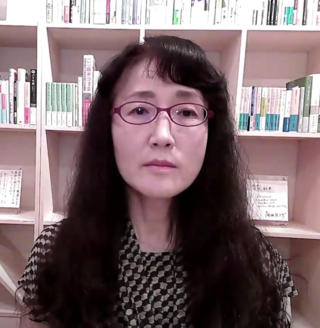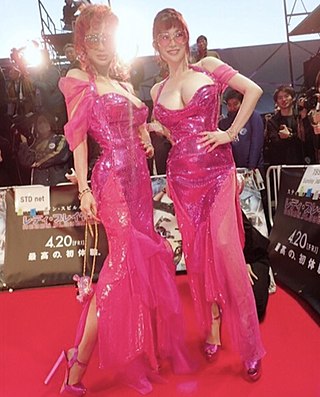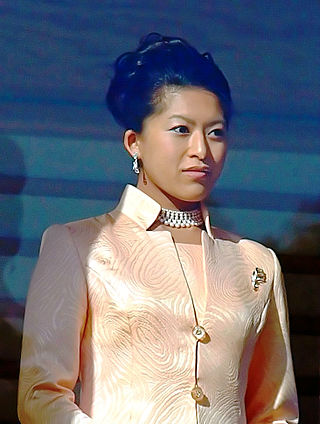Related Research Articles

The mass media in Japan include numerous television and radio networks as well as newspapers and magazines in Japan. For the most part, television networks were established based on capital investments by existing radio networks. Variety shows, serial dramas, and news constitute a large percentage of Japanese evening shows.

Machiko Hasegawa was a Japanese manga artist and one of the first female manga artists. She started her own comic strip, Sazae-san, in 1946. It reached national circulation via the Asahi Shimbun in 1949, and ran daily until Hasegawa decided to retire in February 1974. All of her comics were printed in Japan in digest comics; by the mid-1990s, Hasegawa's estate had sold over 60 million copies in Japan alone.

Miri Yu is a Zainichi Korean playwright, novelist, and essayist. Yu writes in Japanese, her native language, but is a citizen of South Korea.

Misuzu Kaneko was a Japanese poet, known for her poetry for children. She was born Teru Kaneko in the fishing village of Senzaki, now part of Nagato, Yamaguchi prefecture. Motifs of fishing and the sea often make appearances in her poems. Celebrated during her lifetime, her works fell into obscurity after her death, until being rediscovered in the 1980s. Since then, she has been regarded as one of Japan's most beloved children's poets.

Seiko Noda is a Japanese politician who served as Minister-in-charge of Measures against Declining Birthrate from October 2021 to August 2022. A member of the Liberal Democratic Party, she previously served as Minister for Internal Affairs and Communications from 2017 to 2018 under Shinzo Abe. Noda also serves in the House of Representatives, serving her fifth term for the 1st District of Gifu Prefecture. She is a self-described conservative and was a candidate in the 2021 Liberal Democratic Party Leadership Election, however she was eliminated in a run-off, placing fourth in the first round.

Kyoko Kano and Mika Kano, known collectively as the Kano sisters, are Japanese celebrities.

Princess Tsuguko of Takamado is a member of the Imperial House of Japan and the eldest daughter of Norihito, Prince Takamado, and Hisako, Princess Takamado.
John Wilson was the Anglicized name of Captain Frederick Walgren, a Swedish sailor and o-yatoi gaikokujin who was active in the development of British-Japanese ties in the late 19th century.
Sophia Wilson was a Japanese courtesan who married Captain John Wilson. She anglicised her name from Naka Yamazaki to Sophia Wilson, and adopted her son, Nils Wilson. Upon her marriage, she renounced her membership in the Yamazaki koseki, or family record, became a Swedish citizen, and was baptized in the Church of England (Anglican).
Mary Ann Vaughn, a.k.a. Marianne Wilson, is a citizen of Sweden who was the subject of a widely publicised and highly controversial case in international family law decided in the Tokyo High Court in 1956, Sweden v. Yamaguchi. Vaughn became the ward of the Swedish Ambassador to Japan, Tage Grönwall and later Karl Fredrik Almqvist, and resided in the Swedish Embassy in Tokyo.
Norimitsu Onishi is a Japanese Canadian journalist. He is a Paris correspondent for the New York Times, after holding the position as Bureau Chief in Johannesburg, Jakarta, Tokyo and Abidjan.

Miyuki Ishikawa was a Japanese midwife, real estate agent and serial killer. During the US occupation of Japan, she and several accomplices are believed to have murdered dozens of infants, a crime spree known as the Kotobuki San'in incident.

Shōtarō Ikenami was a Japanese author. He wrote a number of historical novels. He won the Naoki Award for popular literature in 1960. Many of his historical novels were adapted for TV and cinema.

Machida Chūji was a politician and cabinet minister in the pre-war Empire of Japan.
Takashi Uemura is a Japanese academic and former journalist who, while a reporter for The Asahi Shimbun, wrote about comfort women. He later came under scrutiny for alleged inaccuracy of terminology and omissions of information. Rival newspapers attacked him for twisting the truth, and more far-right figures went so far as to accuse him of fabrication.
Shūkan Bunshun is a Japanese weekly news magazine (shūkanshi) based in Tokyo, Japan, known for its investigative journalism and frequent clashes with the Japanese government. It is considered one of the most influential weekly magazines in the country.
Yurie Omi is a Japanese former announcer and news anchor for NHK. She left NHK in March 2021. She was famous for being the co-host of NHK's morning talk show Asaichi as well as its geological television series Bura Tamori.
Naomi Sagara is the stage name of Nahoko Yamaguchi, an award-winning Japanese popular singer who was prolific between 1967 and 1980. She won numerous awards as a singer and composer, branching into acting. After a surgery to remove polyps on her vocal cords in 1985, she became a business woman. Since 1993, she has worked in the field of animal welfare and has published several books about animal care. She has periodically returned to television in guest appearances and in 2010 resumed singing and composing.
Shiori Itō is a Japanese journalist and filmmaker. Her work focuses on gender equality and human rights issues. Itō's activism led to her inclusion in the Time 100 Most Influential People of 2020.
Noriyuki Yamaguchi is a former Japanese journalist and biographer of former Japanese Prime Minister Shinzo Abe. He is accused of raping Shiori Itō, who was an intern at Thomson Reuters. His denials and the police refusing to press rape charges against Yamaguchi sparked the Me too movement in Japan.
References
- Shukan Shincho Weekly, 2/25/56
- Kanagawa Shimbun 3/08/56, 3/15/56
- Asahi Shimbun 3/8/56, 3/13/56, 3/14/56,3/18/56, 3/21/56 & 3/31/56
- Nikkan Sports 3/21/56
- 'A Public Betrayed': The Power of Japan's Scandal-Breaking Weeklies, Japan Media Review